Before and after photos on tooth fractures broken teeth and cracked fillings performed in our Cosmetic Dentistry office.
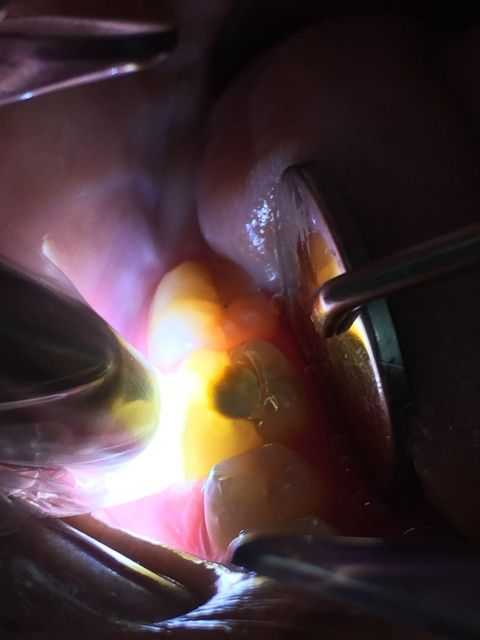
Transillumination shows a fracture in a lower right molar tooth. Notice the light source is applied to the buccal or cheek side of this tooth. Also notice that the light appears to travel halfway through this tooth towards the tongue where a dental mirror is holding it back. The fracture in this tooth may be seen at the junction where the light stops. In the middle of the biting surface of this tooth one may also see a circular temporary filling that was placed after another dentist performed root canal therapy in this tooth. The patient was in extreme pain. After the diagnosis of this fracture by an endodontist an oral surgeon extracted this tooth.
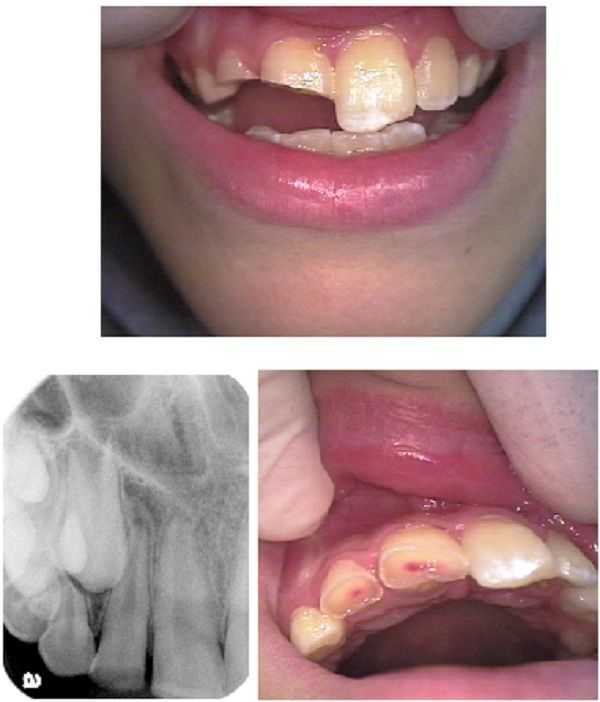
This child fell and broke his two adult teeth whose roots were not yet completely formed. Apexification, or helping the final root apex development, of these teeth is very important. A partial pulpotomy using MTA was performed.
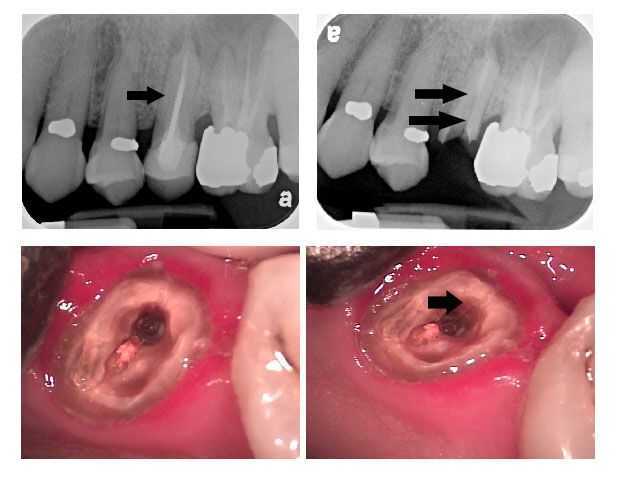
Diagnosis of a fracture in tooth #13. Patient presented with a temporary post and temporary dental crown in a tooth where the prior cast gold post and core and crown came out twice. Tooth fracture was suspected and confirmed with the post out. Pt scheduled for tooth extraction and dental implant placement one month later.
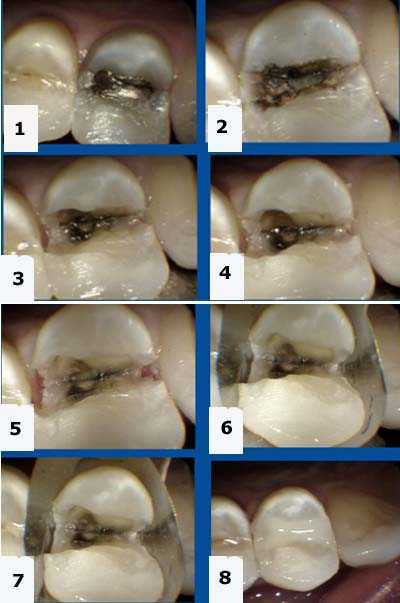
How to pictures drilling a tooth for removal of a cavity dental caries while following a deep crack fracture within the tooth. Note that in the series of pictures # 1-8 that the cracked tooth fracture was removed from the outer tooth enamel but remained within dentin. The area around the remaining fracture line within dentin was not soft. The patient was informed about the need to reevaluate this tooth over time for a full coverage dental crown and possible need for root canal therapy.
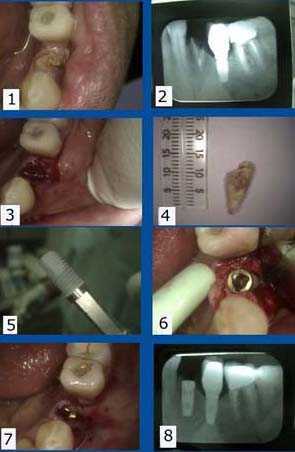
Single tooth dental implant placement after extracting a fractured cracked – but not infected – lower left first premolar tooth. The lower left second premolar position already has a dental implant as well. 1) – 2). Pre-op pictures show the cracked tooth, clinically and in an x-ray. 3) The tooth socket is exposed and ready for dental implantation. 4) The extracted tooth. 5) A Replace titanium threaded dental implant ready for insertion.
6) The dental implant was inserted into mandible lower jaw using a slow speed handpiece.
7) The dental Implant is covered and surrounding soft gum tissue is sutured using 3-0 chromic gut dissolvable sutures. 8) Post-op xray.
6) The dental implant was inserted into mandible lower jaw using a slow speed handpiece.
7) The dental Implant is covered and surrounding soft gum tissue is sutured using 3-0 chromic gut dissolvable sutures. 8) Post-op xray.

Broken Tooth how to pictures for a chipped cracked distolingual tooth cusp. Removal of a large silver amalgam tooth filling and dental bonding. 1) The fractured tooth cusp. 2) Removal of the silver dental filling. 3) Tooth decay removed. 4) The tooth bonding.
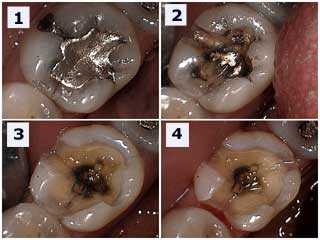
Tooth decay drilling removal under a large amalgam silver dental filling reveals a crack fracture line in the tooth. 1) The large silver tooth filling shows a mesial interproximal crack line. 2) Amalgam removal still shows the presence of the tooth crack line. 3) This mesial crack line is now seen to be continuous through the middle of the tooth and out towards the buccal. 4) The crack line has been removed as much as possible without invading the pulp chamber. Root canal therapy and a dental crown would be the most predictable method to keep the mesio-buccal cusp from further cracks. A dental bonding restoration would be a second choice but would help to prevent further cracking particularly if the mesio-buccal cusp was reduced occlusally and the bonding was overlayed. A non-bonded amalgam silver filling would probably exacerbate the fracture over time.

Trauma to a lower left teeth bridge resulting in a broken cracked tooth. 1) The initial x-ray shows the three teeth dental bridge and a cracked premolar tooth. 2) The second molar showing a furcation involvement and thickening of the periodontal ligament space around the mesial root. The cracked fractured tooth and the mesial tooth root of the second molar were extracted. 3) Intra oral photo following wound healing. The patient was informed about the long span space between these teeth and declined dental implants. He wanted a new fixed teeth bridge anyway. 4) Radiographic healing of the distal tooth root of the second molar after six weeks. The lesson here is the value of salvaging individual roots of molar teeth.

A tooth crack is sometimes found beneath deep silver dental fillings. It seems that large silver dental fillings can sometimes act as a wedge separating buccal and lingual cusps. It is important to remove the entire visible crack fracture or chip especially if it extends to the outer tooth surface. A full coverage restoration tooth crown is usually indicated as a replacement; a tooth bonding restoration would be a second choice to help reduce progression of the crack.

A broken tooth fracture in the upper anterior present a cosmetic challenge if the patient has a high lip line. Tooth extraction may be the best cosmetic choice if crown lengthening is needed. If attempted, crown lengthening gum surgery should focus on obtaining tooth stucture from the palatal to compensate for limited labial gingival reduction. Failure will usually occur labially.
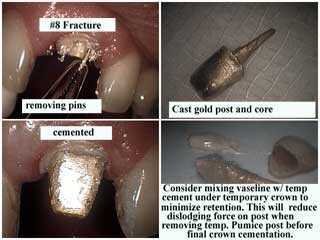
A broken tooth #8 that cracked fractured and a cast gold post and core was inserted with dental cement. Consider placing minimal temporary dental cement – near the gingival margin – under the temporary dental crown to minimize retention. This will reduce the dislodging force on the post when temoving the temporary dental crown. Pumice the post before final crown cementation.
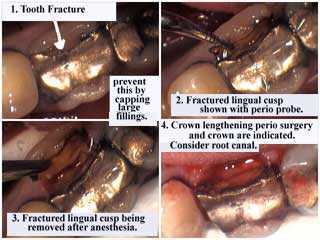
Placing a tooth crown dental cap over a large tooth filling will help prevent a vertical tooth fracture and other possible cracks and chips below the gum.
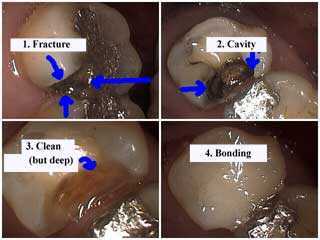
These pictures show tooth bonding used to treat a fractured silver tooth filling. Bonding actually refers to the glue that attaches to the tooth before the white filling material is placed.
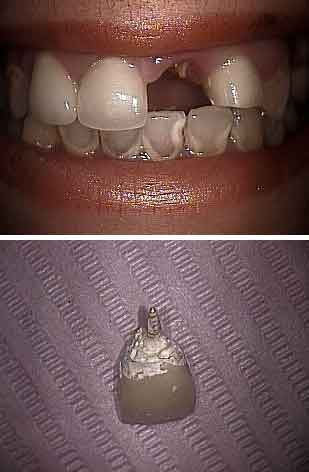
Emergency visit for a broken tooth crown (#9) that had fallen out. This dental crown appears to have been cemented with lots of excess dental cement with the hope of providing retention. It didn’t work. The crown margin appears to end on the post and core, not on solid tooth structure. This also won’t work. The high lipline prevents crown lengthening periodontal gum surgery. The patient was informed that extraction, then dental implant or fixed teeth bridge, was ideal treatment. This dental cap was recemented at patient request after the patient signed an informed consent that it could come out again and be swallowed or aspirated.
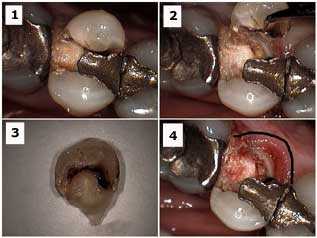
Broken tooth fracture. 1) The entire lingual cusp of this upper premolar tooth cracked and can be seen separated from the dental caries around the silver tooth filling. 2) The cracked lingual tooth cusp is being lifted away from the tooth. 3) The chipped tooth cusp. 4) The tooth after the removal of the fractured cusp. The black line indicates the anticipated extent of crown lengthening periodontal gum surgery that will be necessary.
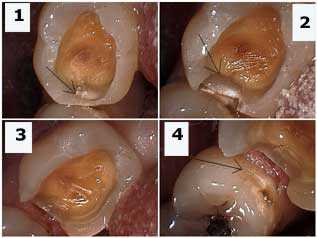
Proper tooth cavity preparation drilling requires the removal of crack lines that could contribute to recurrent tooth decay. 1) The arrow points to a crack line – craze line – extending interproximally. This crack line can be either white or black. 2) Preparation of a mesial box still shows the presence of the crack fracture surrounded by white tooth decalcification. 3) Appropriate removal of the crack. 4) The arrow points to a crack line adjacent to visible decalcification in the adjacent tooth. Reevaluate the bite wing x-rays; this tooth should probably also be treated. Note: sometimes it might be necessary to prepare a narrow channel with a 169 carbide steel bur to just remove a crack fracture without unnecessary tooth preparation. This channel could be filled with flowable composite tooth bonding material.
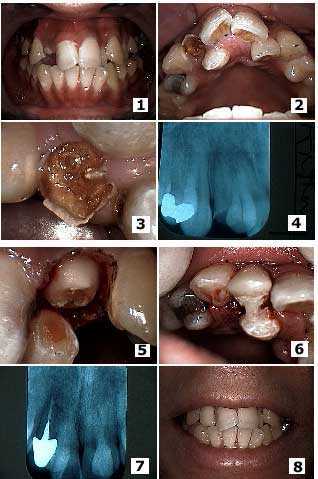
Treatment of a broken tooth with dental caries adjacent to a palatally-displaced supernumerary extra tooth. Photos 1) – 2) Initial presentation. Note the lateral incisor tooth with an obvious cavity and the palatal location of the adjacent supernumerary extra tooth. 3) Close up photo of the broken, decayed lateral and the adjacent palatally-displaced supernumerary tooth. 4) Xray 5) The same tooth after gum surgery and initial tooth preparation drilling. 6) Placement of the temporary crown. Note that acrylic was extended from the temporary on the lateral to the supernumerary to provide initial stability of the temporary crown until root canal therapy and a cast post and core was placed. 7) Radiograph of the final root canal therapy, cast post and core and crown. 8) Final result.